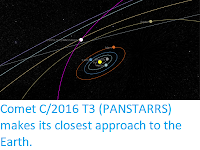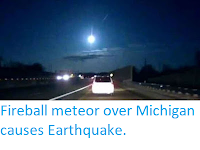Asteroid 2018 BN6 passed by the Earth at a distance of about 362 500
km (0.94 times the average distance between the Earth and the Moon, or
0.24% of the distance between the Earth and the Sun), at about 9.30 am
GMT on Wednesday 24 January 2018. There was no danger of
the asteroid hitting us, though were it to do so it would not have
presented a significant threat. 2018 BN6 has an estimated
equivalent
diameter of 8-28 m (i.e. it is estimated that a spherical object
with
the same volume would be 8-28 m in diameter), and an object of
this
size would be expected to explode in
an airburst (an explosion caused by superheating from friction with the
Earth's atmosphere, which is greater than that caused by simply
falling, due to the orbital momentum of the asteroid) in the atmosphere
between 35 and 18 km above the ground, with only fragmentary material
reaching the Earth's surface.
The calculated orbit of 2018 BN6. Minor Planet Center.
2018 BN6 was discovered on 27 January 2018 (three days after its closest approach to the Earth) by the
University of Arizona's Mt. Lemmon Survey at the Steward Observatory on Mount
Lemmon in the Catalina Mountains north of Tucson. The designation 2018 BN6
implies that the asteroid was the 173rd object (object N6) discovered in the second half of January 2018 (period 2018 B).
2018 BN6 has a 429 day orbital period and an eccentric orbit
tilted at an angle of 2.50° to the plane of the Solar System, which
takes it from 0.73 AU from the Sun (i.e. 73% of he average distance at
which the Earth orbits the Sun, slightly outside the orbit of Venus) to 1.49 AU from the Sun (i.e. 149% of
the
average distance at which the Earth orbits the Sun, and slightly inside the orbit of the planet Mars). It is therefore
classed as an
Apollo Group Asteroid (an asteroid that is on average further from the
Sun than the Earth, but which does get closer). This means that the
asteroid has occasional close encounters with the Earth, with the
last thought to have occurred in April 2017 and the next predicted
in February 2025. The asteroid also has occasional close encounters with the planet Venus, with the next predicted for 25 October 2023.
See also...
Follow Sciency Thoughts on Facebook.







